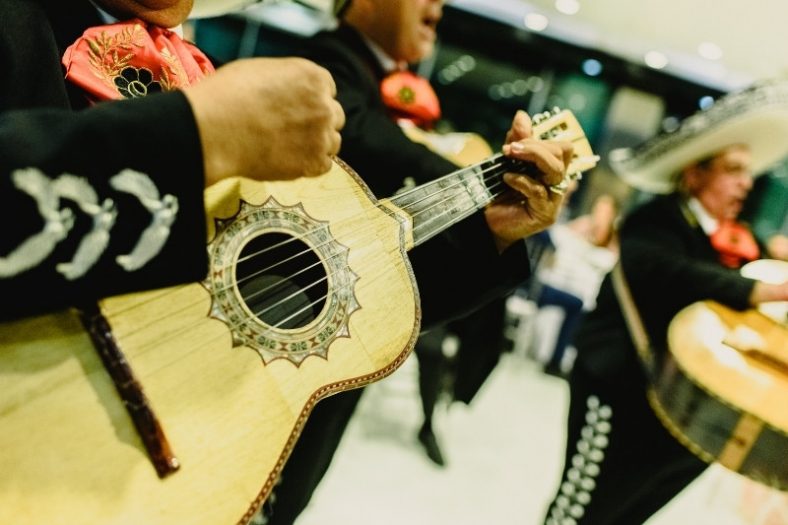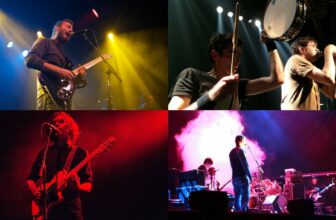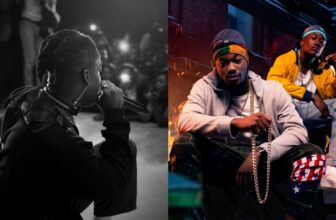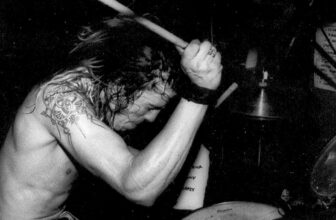15 Types Of Mexican Music

Reflecting the diverse heritage of Mexico, Mexican music encompasses a range of musical styles and genres. While indigenous people provided the foundation, contemporary Mexican music was produced during and after Spanish colonization.
In the 19th and 20th centuries, the music adopted a more nationalist fervor and greater emphasis was placed on maintaining a national artistic identity. Today, traditional music as well as Mexican art music continue to be enjoyed in Mexico and around the world.
Contents
1. Mariachi
Mariachi is one of the most well-known forms of Mexican music. Although its origins as a regional musical genre date back to at least the 18th century, mariachi music that is enjoyed today has evolved considerably due to the influence of Mexican ‘son’ music as well as European musical genres.
In Mexico, mariachi music has become an urban phenomenon, partly as a result of the Mexican government promoting mariachi as an international symbol of the country. Rancheras, corridos, boleros, ballads, pasodobles, and waltzes are some of the song styles that can be found in this genre.
Mariachi groups are typically small ensembles that use primarily stringed instruments. Vicente Fernandez, Luis Miguel, and Lola Beltran are examples of famous mariachi singers.
2. Ranchera
Taking its name from the ranch lands from which the music originated, ranchera music has become a symbol of national consciousness in Mexico. Despite having its roots in rural folk music, the ranchera has become very popular in urban centers.
Ranchera songs include rhythms inspired by waltz, bolero, and polka. Guitars, accordions, and trumpets are the most often used instruments. Lyrics typically focus on love and are frequently delivered with dramatic emotion.
Rancheras are performed by mariachi bands, street performers, and leading pop stars. Some of the most noted ranchera singers include Vicente Fernandez, Pedro Infante, and Pepe Aguilar.
3. Banda
Banda or band music is a type of regional Mexican music that primarily utilizes wind music, predominantly brass and percussion.
Banda music is influenced by the rhythms of traditional dances such as waltz, polka, and son, as well as more modern inspirations such as electronic music techniques. Banda music is frequently hyperactive, encouraging dancers to jump, spin, and swing their partners.
Today, banda music encompasses a range of styles including ballads, salsa, bachata, mambos, tangos, and swing. Possibly the most popular banda song is “El Sinaloense”. Famous proponents of banda music include singers such as Valentin Elizalde and El Chapa de Sinaloa as well as bands such as Banda el Recodo.
4. Corrido
The corrido is a popular musical genre in Mexico and is typically a ballad that narrates a historical event or other socially relevant topics. In its most popular form, it consists of a salutation and prologue to the story, followed by the story itself.
The corrido is concluded with a prologue along with a moral and the singer’s farewell. However, modern corridos don’t adhere very strictly to this structure.
Outside of Mexico, corridos are popular in Chile and the southwestern United States. It has even influenced American social justice songs in the 1960s and 1970s, as well as hip-hop music. Top corridos artists include Ramon Ayala, Gerardo Ortiz, and Larry Hernandez.
5. Son
Son, which means sound in Spanish, is a term that is applied to different Southern American musical styles. Son Mexicano refers to the folk music and dance that incorporates different regional genres found in Mexico. As such, it is unrelated to Son Cubano and other similar folk styles.
Son Mexicano incorporates elements of Baroque music from Spain which was introduced in the colonial era. The music typically uses string instruments such as guitars, harps, and violins. It is often performed in a social setting with performers or dancers stomping to provide percussion. Noteworthy son bands include Trio Los Chiles, Son del Pueblo, and Cana Dulcey cana brava.
6. Norteño
Norteño is a popular form of Mexican music that has spread from rural areas to urban centers, and even to other countries such as the United States, Columbia, and Chile. It developed in the 19th century as a synthesis of traditional Mexican music and Spanish musical traditions, along with the influence of folk music from Austria and Germany.
The most common instruments for Norteño music are the Baja Sexto and the accordion. While love is a popular theme, Norteño music also deals with social issues and covers musical styles such as ballads, bolero, cumbia, and polka.
Famous Norteño singers and bands include Ramon Ayala and Los Tigres Del Norte.
7. Chicano Rap
Chicano rap emerged in the late 1980s from the West Coast Rap movement. Although early Chicano rappers didn’t see themselves as part of a new movement, Chicano rap music took on a vibe and language of its own. Chicano rap uses a language called Calo, which is a mixture of Spanish, English, and indigenous languages.
Kid Frost was the first well-known Chicano rap artist, who received recognition for his 1990 debut album. Mellow Man Ace, A.L.T., and Lil Rob are other reputed Chicano rappers. Chico rap is most popular among Latinos living in the United States but also has listeners among hip hop fans in the US, Australia, and UAE.
8. Grupera
Grupera is a style of regional Mexican folk music that was especially popular in rural areas in the 1990s. Grupera music subsequently gained the attention of the music industry and received more airplay from radio stations.
Legendary singers such as Selena helped popularize grupera music on both sides of the border. Other top grupera singers include Joan Sebastian, Alejandro Fernandez, and Ana Gabriel.
Today, grupera is typically performed by bands of five members or less. Electric guitars, drums, keyboards, and bass are the instruments that are most commonly used.
9. Chicano Rock
Unlike other types of Mexican music, Chicano rock doesn’t refer to a particular genre of music. Rather, it is defined by the fact that the performers are of Mexican origin. As such, diverse song styles can be found in Chicano rock, with some of the lyrics not even being in Spanish.
Chicano rock originated in East Los Angeles and had a strong rhythm and blues influence, along with a mixture of rock and roll. Chicano rock later took inspiration from other musical styles such as blues, soul, funk, and jazz.
Many legendary artists such as Ritchie Valens, Linda Ronstadt, and Carlos Santana contributed to the popularity of Chicano rock.
10. Duranguense
Duranguense is a style of Mexican music that has been heavily influenced by banda and norteño. It reached the peak of its popularity in the mid-2000s. Due to the banda influence, the saxophone, trombone, and bass drum are typically used to produce duranguense. Synthesizers are additionally used in this music style.
The dance style, Pasito Duranguense, was popularized as a result of duranguense music. Groups such as K-Paz De La Sierra, Alacranes Musical, and Grupo Montez de Durango helped promote this genre of music.
11. Chilena
Derived from the cueca family of musical styles and dance, Chilena is a Mexican musical genre that can be heard along the Costa Chica coastal regions. Since its inception, the genre has adopted various musical styles and fused them together, evolving into a genre itself.
Some good examples of early Chilena music are “Cataclismo En Pinotepa,” “Pinotepa,” and “Corazones Partidos”. However, the genre is considered to be a “Transplanted” musical style that adopts other genres, resulting in songs that can fall under different musical umbrellas.
Some notable Chilena artists are Dúo Cornejo-Cáceres, Alvaro Carrillo, and Los Huasos de Chincolco.
12. Son Jarocho
Son Jarocho is a regional folk style of Mexican Son music that dates back to the 18th century in terms of tradition. The style combines indigenous Mexican music, West African music, and fandango (Spanish Baroque music and dance).
Son Jarocho’s lyrics often talk about love, nature, sailors, and hints of humor, depicting colonial life from the 19th century. This style of music often features repetitive verses and includes instruments such as requinto, arpa jarocha, leona, pandero, quijada, and more.
13. Bolero
A genre of song from eastern Cuba, Bolero is a widely known style that dates back to the late 19th century. Often covering topics regarding love, Bolero has its roots in romantic folk poetry that eventually evolved into the Cuban canción.
Since its inception, the style has spawned several fusion genres such as Bolero-son, Bolero-cha, and Bolero-mambo. Utilizing traditional Mexican instruments, songs like “Besame Mucho” and “Solamente Una Vez” are great examples, as well as “Tristezas” by the father of Bolero – Pepe Sánchez.
14. Tejano
Tejano music is a Mexican style of music that combines US influences, also known as Tex-Mex music. This style of music gained widespread popularity thanks to Selena (“The Queen of Tejano”).
Often considered a natural blend between corrido and mariachi music, Tejano music utilizes the accordion, flute, guitar, and drum, among other instruments, and has various dance rhythms that stem from traditional polka or waltz dances.
15. Nortec
Nortec is a Mexican EDM genre that combines norteño and techno, which is a surprising combination. Its cultural origins date back to the early 2000s and it got fairly popular in a short period of time after that.
This genre is characterized by hard beats and samples of traditional Mexican music such as Norteño, Tambora, and Banda. It came to fruition through experimentation and has since taken off, utilizing traditional instruments (samples) like accordion, tuba, clarinet, horn, and various elements of EDM.
What are common instruments used in Mexican Music?
The instruments commonly used in Mexican music are a mixture of instruments that are unique to the region and others that arrived in the country as a result of colonial influences.
The violin, which was brought by Spaniards to Mexico, is widely used for a variety of Mexican music genres, particularly mariachi. The trumpet is another instrument that is commonly used for mariachi music as well as banda. The accordion and guitar are also very commonly used to play all types of Mexican music.
The Guitarron Mexicano, also known as the big Mexican guitar, is an example of an instrument that has been adopted by Mexican musicians. The Arpa Jarocha (Mexican harp), Bajo Sexto, and Mexican Vihuela are instruments that are also indigenous to the region.
Conclusion
Mexican music continues to win over new listeners worldwide thanks to its fascinating mixture of influences and irresistible, vibrant energy. As their music evolves, we can be sure that Mexican artists will continue to delight music lovers with the infectious beats of their country.





